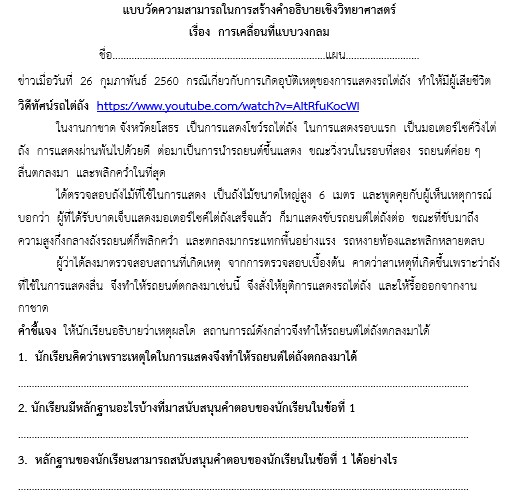การพัฒนาการสร้างคำอธิบายเชิงวิทยาศาสตร์ของนักเรียนชั้นมัธยมศึกษาปีที่ 4 ในบทเรียนเรื่องการเคลื่อนที่แบบต่าง ๆ โดยการจัดการเรียนรู้ที่ใช้บริบทเป็นฐาน
Main Article Content
Abstract
Developing Grade 10 Students’ Scientific Explanation in the Topic of Motions by Using Context–Based Learning
Suchada Srisakuna
รับบทความ: 24 เมษายน 2564; แก้ไขบทความ: 29 สิงหาคม 2564; ยอมรับตีพิมพ์: 18 กันยายน 2564; ตีพิมพ์ออนไลน์: 20 เมษายน 2565
บทคัดย่อ
การวิจัยนี้มีวัตถุประสงค์เพื่อศึกษาความสามารถในการสร้างคำอธิบายเชิงวิทยาศาสตร์เรื่องการเคลื่อนที่แบบต่าง ๆ ของนักเรียนชั้นมัธยมศึกษาปีที่ 4 ด้วยการจัดการเรียนรู้โดยใช้บริบทเป็นฐาน กลุ่มที่ศึกษาในงานวิจัยนี้ ได้แก่ นักเรียนชั้นมัธยมศึกษาปีที่ 4 ของโรงเรียนสาธิตแห่งมหาวิทยาลัยเกษตรศาสตร์ ศูนย์วิจัยและพัฒนาการศึกษาประกอบด้วยนักเรียนชาย 30 คน นักเรียนหญิง 30 คน โดยคละความสามารถ ได้มาจากการเลือกแบบเจาะจง งานวิจัยนี้มีแผนการจัดการเรียนรู้โดยใช้บริบทเป็นฐาน จำนวน 4 แผน แบ่งเป็น 4 วงจรการวิจัยปฏิบัติการในชั้นเรียน เก็บรวบรวมข้อมูลโดยใช้แบบวัดการสร้างคำอธิบายเชิงวิทยาศาสตร์ โดยแบบวัดการสร้างคำอธิบายเชิงวิทยาศาสตร์มี 3 องค์ประกอบ ได้แก่ ข้อกล่าวอ้าง หลักฐาน และการให้เหตุผล โดยศึกษาเนื้อหาเรื่องการเคลื่อนที่แบบต่าง ๆ แล้วนำมาวิเคราะห์เพื่อสร้างเป็นสถานการณ์ที่ใช้ในแบบวัดความสามารถในการสร้างคำอธิบายเชิงวิทยาศาสตร์ และนำแบบวัดการสร้างคำอธิบายเชิงวิทยาศาสตร์ที่สร้างขึ้น ปรึกษาผู้เชี่ยวชาญ และทีมครูผู้สอนร่วม เพื่อตรวจสอบความถูกต้องและความเหมาะสมของแบบวัด ทั้งสถานการณ์ ข้อคำถามและเกณฑ์การตอบคำถาม เนื้อหา ภาพประกอบ และความถูกต้องของภาษา ผลการวิจัยพบว่าภาพรวมของความสามารถในการสร้างคำอธิบายเชิงวิทยาศาสตร์ของนักเรียนจากแบบวัดอยู่ในระดับพอใช้คือ 0.95 (คะแนนเต็ม 2.00 คะแนน) เมื่อพิจารณาในแต่ละองค์ประกอบพบว่านักเรียนมีความสามารถในการสร้างข้อกล่าวอ้างมากที่สุดคือ 1.10 คะแนน และสามารถแสดงหลักฐานรองลงมาคือ 1.00 คะแนน และคะแนนด้านการให้เหตุผลต่ำสุดคือ 0.75 คะแนน โดยระหว่างการจัดการเรียนรู้ในช่วงแผนที่ 1 และแผนที่ 2 พบว่านักเรียนมีคะแนนทุกด้านค่อนข้างต่ำ โดยเฉพาะการให้เหตุผล เนื่องจากนักเรียนคุ้นชินกับการตอบเป็นตัวเลข ครูจึงเปลี่ยนรูปแบบของการถามคำถามเน้นเป็นคำถามที่นักเรียนต้องอธิบายด้วยหลักการทางวิทยาศาสตร์แบบมีเหตุผล เมื่อนักเรียนสามารถเขียนในองค์ประกอบของการให้เหตุผลแล้ว ในแบบวัดต่อมาครูลดบทบาทลง เพื่อส่งเสริมให้นักเรียนสามารถสร้างคำอธิบายเชิงวิทยาศาสตร์ได้ด้วยตนเอง
คำสำคัญ: การจัดการเรียนรู้โดยใช้บริบทเป็นฐาน การสร้างคำอธิบายเชิงวิทยาศาสตร์ การเคลื่อนที่แบบต่าง ๆ
Abstract
This research aimed to study of grade 10th student’s scientific explanation ability in topic of different types of movement of using context–based learning. The participants were grade 10th students in Kasetsart University Laboratory School, Center for Educational Research and Development consisted of 30 males and 30 females with mixed learning ability and selected purposively. Data were collected by using the scientific description creation test. The scientific explanation was considered in 3 components which solved the claims, evidences and reasoning. The researchers studied various types of motion and analyzed them to create situations used in the ability to create scientific explanations and use the scientific description creation model to create expert consultation and teacher team together in order to check the accuracy of the content measurement, illustrations, language accuracy suitability of the situation and appropriateness of questions and answers. The findings showed that the grade 10th student’s scientific explanation was at a fair level of 0.95 points (2.00 points in toto). When considering each component, students had the ability to create claim was 1.10 points and followed with evidence was 1.00 points and reasoning was 0.75 points. During the learning management in lesson plan 1 and 2, it was found that the students had relatively low scores in all aspects, especially in reasoning aspect. This was because students were used to answering questions with numbers. The teachers then changed the style of asking focusing on questions that students had to explain with rational scientific principles. When students were able to write in the reasoning element, teachers had to reduce their roles in order to encourage students to create their own scientific explanations.
Keywords: Context–based learning, Scientific explanations, Motions
Downloads
Article Details

This work is licensed under a Creative Commons Attribution-NonCommercial 4.0 International License.
References
Bennett, J. (2003). Teaching and Learning Science: A Guide to Recent Research and Its applications. London: Continuum.
Boonrod, J. (2015). Effects of science instructtion using more model on science learning achievement and scientific explanation ability of lower secondary school. JED an online Journal of Education (10): 238–248. (in Thai)
Chumsaeng, T. (2017). The development of grade 10 students’ scientific explanation ability in equilibrium unit using context–based approach. National Graduate Research Conference (pp.1178–1189). Khon Kaen: Khon Kaen University. (in Thai)
Gilbert, J. K. (2006). On the nature of context in chemical education. International Jour-nal of Science Education 28(9): 957–976.
Hongkerd, O. Pitiporntapin, S. and Chumnanpuen, P. (2018). Best practices for using socioscientific issues to develop scientific explanation in learning unit of endocrine system. Journal of Research Unit on Science, Technology and Environment for Learning 9(2): 211–226. (in Thai)
Joyce, B, and Weil, M. (1996). Model of Teaching. 5th ed. Boston: Allyn and Bacon.
Jutanaruepakit, K. (2018). Implementing scientific inquiry approaches to develop grade 10th students’ scientific explanation in the topic of circular motion. The 13th RSU National Graduate Research Conference (pp. 1741–1753). Bangkok: Rangsit University. (in Thai)
Lertdechapat, K. (2016). Effects of collaborative inquiry on ability in scientific explanation making and collaborative problem solving of lower secondary school students. The 6th International Conference for Science Educators and Teachers (pp.16–28). Bangkok, Thailand. (in Thai)
McNeill, K. L., and Krajcik, J. (2008). Assessing middle school; students’ content knowledge and reasoning through written scientific explanation. In National Science Teacher Association, Assessing Science Learning (pp.101–116). NSTA: Virginia.
Ministry of Education. (2009). Basic Education Core Curriculum 2008. Bangkok: Agricultural Cooperative Printing. (in Thai)
Patwong, S. (2019). Effects of context–based learning (CBL) together with pro strategy technique on grade 11 students’ ability in constructing scientific explanation in the topic of sound. The 21thNational Graduate Research Conference (pp.539–550). Khon Kaen: Khon Kaen University. (in Thai)
Seel, N. M. (2012). Encyclopedia of the Science of Learning. London: Springer Science+ Business Media.
Sirithon, N. (2019). Implementing argument–driven inquiry approach for developing grade 10th students’ ability in making scientific explanation in the topic of force, mass, and law of motion. Silpakorn University Journal 39(1): 130–141. (in Thai)
The Institute for the Promotion of Teaching Science and Technology. (2021). PISA Assessment Results 2018 Reading, Mathematics and Science. Bangkok: Author. (in Thai)
Wiyarsi, A. Pratomo, H. and Priyambodo, E. (2020). Vocational high school students' chemical literacy on context–based learning: A case of petroleum topic. Journal of Turkish Science Education (TUSED) 17(1): 147–161.
Yu, K. C., Fan, S. C., and Lin, K. Y. (2014). Enhancing students’ problem–solving skill through context–based learning. International Journal of Science and Mathematics Education 13: 1377–1401.
